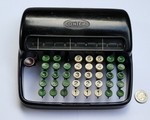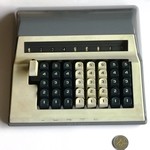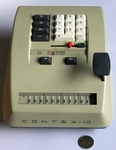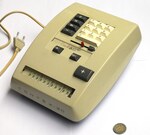



Introduction
Models
Contex A
Contex A Video
Contex B
Contex B Video
Instruction Leaflets
Contex A/B Clones
Contex 10
Contex 10 Video
How To Use a Contex 10
Contex 30
Contex 30 Video
Manuals
Promotional Material
Advertisements
Patents
Links
The company "Brdr. Carlsen" (i.e. the Carlsen Brothers) was founded by the three brothers John, Henning, and Erling Carlsen in 1945 in Hellerup, Denmark. It was to produce the simple calculator that they had designed and patented. The Zeuthen og Aagaard office supply company became interested in distributing them, and production soon moved to a new factory in Gentofte to keep up with the demand. A few years after a new model began to be produced in 1957, they moved to yet another factory in Birkerød. The company was dissolved in 1972 when electronic calculators made the electromechanical calculators obsolete. The Contex brand name was then used for a number of electronic calculators and is still in use now as a brand of document scanner.
Contex started in 1945 with a simple half-keyboard adding machine that is similar to the Plus adder by Bell Punch, except that it had its display register above the keyboard instead of in front of it, and was much more cheaply made. Its keyboard has 8 columns of 5 keys, and a 9-digit register. There are versions with a decimal keyboard, and versions for use with English currency (pounds, shillings, pence, or pounds, shillings, pence, farthings).
The first version of the Contex, nowadays called the model A, had a dark brown
Bakelite case (later white plastic), and an open keyboard a bit like that of a typewriter.
In about 1951 the machine was given a new design by Sigvard Bernadotte,
and this is now called the model B. It had a grey and white plastic case, and a
keyboard more like that of a computer, with black and white square keys with
almost no gaps between them. The internal mechanism was virtually identical to
model A.
Later they created a more complicated series of models with a 10-key keyboard, still cleverly constructed so as to be as cheap to manufacture as possible.
Contex 10 was the first of these, released in 1957. Like the model B, the case
was again designed by Sigvard
Bernadotte. The first versions had a grey case, but later they changed
that to a lighter beige colour. There is a 10-digit register at
the front, with an extra 1-digit counter which is used for division.
It has ten keys for the digits, a clear key, keys for multiplication, subtraction,
and division, as well as keys for shifting the input to the left or right.
Apart from the keys there is a large push button (almost a lever) that performs
an addition or subtraction. An explanation of how to use it can be found below.
These models were electrically driven calculators, all clearly based on the design of the Contex 10. The Contex 20 was released in 1960, and is essentially the same as the Contex 10 except that there is no heavy push button for performing an addition, and instead that is replaced by a simply key that causes the work to be done electrically. The functionality of the Contex 20 is virtually identical to the Contex 10.
The Contex 30, released in 1963, improves on the Contex 20 by including automatic
multiplication. You had to enter the second number of the multiplication from right to left,
and it would perform the multiplication as you entered it. Division was still performed
one digit at a time however. The Contex 55, released in 1967, had automatic division and
had a second output register especially to store the division result.
The table below shows the years of production, the approximate amounts produced, and some of the serial numbers that I have found in various other online sources. From about 1961 onwards, the serial number is preceded by a 3-digit code which specifies the exact model type, and below I have enclosed that in brackets. The exact ranges and dates of the serial numbers are unclear.
| Model | Amount produced | Years of production | Serial Numbers |
|---|---|---|---|
| Contex A | 48,000 | 1945-1951 | 37338; 41230; 41337; 42084; 67332; 69972; 73053; 79192; 79390; 82354; 83167; 86860; 116263; 118768; 124773; 124911; 130014; 130161; 131698; 156596; 158589; 165565; 168410; 180380; 180922; |
| Contex B | 189,609 | 1951-1970 | 137386; 140858; 155105; 203419; 203653; 205079; 246818; 537817; 911428; 945937; 946514; (411)003870; (411)017042; (411)024875; (411)605885 |
| Contex 10 | 1,059,381 | 1957-1971 | 425901; 447531; 467745; 512714; 762204; (421)003019; (424)001829; (431)027205; (431)808360; (434)005097; (434)039458; (434)077240 |
| Contex 20 | 392,668 | 1960-1971 | 619746; 623994; 668711; (453)004781; (453)012430 |
| Contex 30 | 393,000 | 1963-1971 | (473)048358; (473)080824; (473)022492; (473)086504; (473)134098; (473)148242; (473)150856; (473)169919; (473)174815 |
| Contex 55 | 145,833 | 1967-1971 | (483)004617; (483)007548; (493)005189; (493)011463; (493)016818; (493)035101; (493)058403; (493)059918; (493)088787 |
| Total | 2,228,491 | 1945-1971 |
The Contex A is a key-driven adding machine produced from 1945 until about 1951. Its register is located behind the keyboard and has 9 digits. The keyboard has 8 columns with only five keys, numbered 1 to 5. Entering a digit larger than 5 involves two key-presses - for example to enter 9 in a column you have to press the 5 and then the 4 (or vice versa). During the downstroke of a key, the digit you entered is added to the corresponding digit in the register.
On the left of the keyboard is the clearing button. As you press it down all the digits of the register turn to 9, and when released 1 is added so that the register overflows to zero.
The machine shown here has a standard decimal keyboard (missing one key), and has serial number 69,972. The original rubber feet are still present, but badly deteriorated. Note that it still says Patent Pending on the bottom cover. The remnants of the decal on the back are from the distributor in the Netherlands, Kulk & Kramer Kantoorhandel.
The levers inside the machine are not made of metal but of Pertinax, a composite made of resin bonded paper that is also used for cheap printed circuit boards. The outer casing is made of Bakelite.
The mechanism used in the Contex is simple, and lacks the safety features of
the more expensive machines. The biggest flaw is that partially pressing a key
will only enter part of the number. For example, if you push down on a 5 key but
release it before fully depressing it, then any number from 1 to 4 could be added
to the register. Mis-hitting a key and thereby slightly disturbing an adjacent key
will almost always make the answer incorrect.
If you enter numbers using both hands to enter digits on several columns at
the same time, then you must be sure to move you hands in concert, pushing down
simultaneously and then releasing simultaneously. If one hand lags behind the other,
it is possible for a carry to become lost, resulting in the wrong answer.
The low cost of this machine makes up for these weaknesses.
The machine shown in the next photos is for adding sterling currency. The right-most column is for pennies, displaying any value from 0 to 11. The next two columns are for shillings, displaying values from 00 to 19. The left column of the shillings can only display 0 or 1, and only has a single key that increments it. All the other columns are standard decimal columns for counting the pounds.
On the bottom it has a metal label listing patent numbers and surrounding the serial number 124,911. The rubber feet seem to have been replaced.
The following machine is also for sterling currency, but the right-most column counts farthings (quarter pence), displaying 0, 1/4, 1/2 or 3/4. The keyboard only has two keys in that column. The other columns are like the previous sterling currency machine except that there is only room for four columns for the pounds.
It has serial number 130,014. The rubber feet are completely missing.
Here is a video where I demonstrate my Contex A.
The Contex B that I have has the serial number 537817. This model was introduced in 1951 to replace the functionally identical Contex A, and was produced in steadily declining numbers until 1970. From the serial number, I suspect mine was made in around 1959.
Its register is located behind the keyboard and has 9 digits. The keyboard has 8 columns with only five keys, numbered 1 to 5. Entering a digit larger than 5 involves two key-presses - for example to enter 9 in a column you have to press the 5 and then the 4 (or vice versa). During the downstroke of a key, the digit you entered is added to the corresponding digit in the register.
On the left of the keyboard is the clearing button. As you press it down all the digits of the register turn to 9, and when released 1 is added so that the register overflows to zero.
The levers inside the machine are not made of metal but of Pertinax, a composite made of resin bonded paper that is also used for cheap printed circuit boards. While this kept the weight down of the model A, the casing of model B makes it quite heavy still.
The mechanism used in the Contex is simple, and lacks the safety features of
the more expensive machines. The biggest flaw is that partially pressing a key
will only enter part of the number. For example, if you push down on a 5 key but
release it before fully depressing it, then any number from 1 to 4 could be added
to the register. Mis-hitting a key and thereby slightly disturbing an adjacent key
will almost always make the answer incorrect.
If you enter numbers using both hands to enter digits on several columns at
the same time, then you must be sure to move you hands in concert, pushing down
simultaneously and then releasing simultaneously. If one hand lags behind the other,
it is possible for a carry to become lost, resulting in the wrong answer.
The low cost of this machine makes up for these weaknesses.
Here is a video where I demonstrate my Contex B.
Directions for Contex (PDF, 1.24 MB or archive.org)
8 page stapled booklet
89mm × 145mm
Form CO-1004-EN
Method of Operation - Contex (Sterling Model) (PDF, 1.25 MB or archive.org)
8 page stapled booklet
117mm × 171mm
Form CO-1006-EN
Several clone versions of the Contex A or B were made. Shown here is the Nisa C which seems to be a mix between the two, as it has the square keys of the model B but the rounded bakelite case like the model A. It was made in the late 1950s by Nisa Kalkulacni, which was based in Proseč in Czechia (then Czechoslovakia).
Unfortunately the plastic number wheels seem to have shrunk slightly so that they no longer can move freely on their axle. The clearing button top was also missing, and the previous owner made a wooden replacement for it.
The Contex 10 is a 10-key mechanical calculator. It has a 10-digit internal input register. Typing in a number will set this internal input register, but the only visual sign of this is the red pointer that moves to the left to indicate how many digits you have entered. The input can be added or subtracted from the 11-digit output register at the front of the machine.
My Contex 10 has serial number (434)077240. This model was produced from 1957 till 1971, but in about 1963 (when the Contex 30 came out) it was improved slightly by the addition of a key to the right of the 0 key. My machine is of the improved type, but it is hard to determine its manufacturing date more precisely as the serial numbering scheme is unclear.
The large push-button at the right is pushed to perform an actual addition or subtraction. Pushing this down takes some effort, and this provides the mechanical energy to work the mechanism. On the underside of the machine is a small switch which you can use to lock the push-button on the down position, which helps keep the machine safe and compact for transport or storage. The underside also has a large label with a short instruction manual.
Here is a video where I demonstrate my Contex 10.
Clearing the output register: Press C. Note that this does not affect the input register.
Clearing the input register: Shift red digit pointer to the right as far as possible. If the black stopper button is in the way, move that to the right first.
Inputting a number: The input register should be clear (the red digit pointer is at 0). Simply type the number into the keypad. With every key press, the red pointer moves one step to the left. The input has a maximum of 10 digits, and any further digit keypresses are ignored. If you make a mistake, simply clear the input (as above) and try again. The manual warns against using the → key to correct the last entered digit, but it does seem to work except for the first digit entered.
Addition: Input a number. Push down the big button. This adds the number to the output register at the front, and automatically clears the input for the next number you want to add, so you can repeat the process as often as you need to add a list of numbers.
Subtraction: I assume the output register already holds non-zero number, and that you want to subtract a smaller number from it. Enter the number you want to subtract. Press the - key (which stays depressed), and then push down the big button. The output register will shift to the left, and the entered number gets subtracted from it. The input is cleared automatically, and the - will pop back up. You can then add or subtract another number in the same way.
Back Transfer: The Contex 10 does not have automatic back transfer, but you can manually copy the result from the output register into the input register. To do so, clear the input register. Type in the number showing in the output register. Finally press C to clear the output while keeping the input untouched.
Negative numbers: If you subtract so much that the result would be a negative number, then the output register will underflow. For example, it will show 99999996735, or something similar with leading nines. To negate the number you can simply subtract it from zero as follows: Back transfer as much of the output register as you can, but since you can only input at most 10 digits, you will need to skip (at least) one of the leading nines. In this example you would enter 9999996735 and then press C. Subtract it by pressing -, and then the big button. The result is 90000003265. Ignore the leading nine to conclude that the number represented -3265. You can skip more leading nines during the back transfer, in which case you will have more leading nines to ignore in the end result.
Multiplication: Multiplication is done by repeated addition in much the same way as on traditional pinwheel calculators. Suppose you want to multiply some number X by 157. First input the number X you want to multiply. Press the × key (which will stay depressed). Now work your way through the second number one digit at a time, from right to left. The rightmost digit is 7, so you have to press the big button 7 times. This adds X times 7 to the output register. Note that the counter digit to the right of the output register is useful for keeping count. Then press ← to shift the input to the left. The next digit is 5, so press the big button 5 times. This adds X times 50 to the output register. Press ← once more. The last digit is 1 so press the big button just once, which adds X times 100 to the output. The output register has now had a total of X times 157 added to it, as required. To end the multiplication, clear the input, which also releases the × key. You can follow this by a back transfer if you wish to multiply the result by another number. On the Contex 30 and 55, the repeated addition and shift-left is done for you automatically, and you simply have to enter that second number from right to left.
Advanced Multiplication: Sometimes shortcuts are possible by the use of subtraction. For example, to calculate X × 98, you can do (X × 100)-(X × 2). The latter involves far fewer addition/subtraction operations. To do this calculation, enter the number X, press ×, press ← twice, and then the big button. This has done the first part. Now press → twice to shift the input back to the units position, press - followed by the big button twice. Note that the - key remains down for this operation.
Division: Clear the output and input registers. Enter the first number. Now press ↞, by which I mean the key to the right of the zero. This shifts the input all the way to the left. If you have an older Contex without that key, just press the normal ← key repeatedly until it stops working. Press the big button to add you number to the left of the output register. Enter the second number, your divisor. Again press the ↞ key to shift it all the way to the left. Press Div and the - key, and you're ready to start the division. Repeatedly press the big button, continuing until it locks up. Doing this will have repeatedly subtracted the divisor until the register underflowed, and then added it once to undo the last subtraction. The red counter digit on the right will show the number of times a subtraction was done successfully, so it is the first digit of the answer. Write that digit down. Press →. This shifts the input to the right, and also clears the counter digit, pushes in the - key again and unlocks the big button. Again repeatedly press the big button till it locks, copy down the red digit from the counter as the next digit of the answer, and press →. Continue until you have written down sufficient digits of the quotient.
The Contex 30 is a 10-key electromechanical calculator. It is similar to the Contex 10, except that it is electrically driven, and has automatic multiplication.
Instead of the Contex 10's large button that performs an operation, you
have to press the + or the -
button and the electric motor will kick in and perform the operation.
The × button turns all the number keys into multiplier
keys, so a multiplication is performed by entering the first factor, pressing
the × button, and then entering the second factor from right to left.
When you clear the input by sliding the input indicator to the right, the
multiplication button is released.
Division is performed in the same way as on the Contex 10, except that
the motor automatically starts when the - button or
→is pressed.
My Contex 30 has serial number (473)173863. This model was produced from 1963 till 1971, but it is hard to determine its manufacturing date more precisely as the serial numbering scheme is unclear.
Here is a video where I demonstrate my Contex 30.
Rechenpraxis für Contex-10 und Contex-20 (PDF, 11.6 MB or archive.org)
Rex Rotary Deutschland GmbH
1961
32 page booklet
147mm × 207mm × 3mm
This is a training manual for the Contex-10 and 20. It explains the basic arithmetic operations, and has many examples and practice problems to illustrate their use.
Contex 10/20 Service Manuals and Parts Lists
Zeuten & Aagard A/S, Rex Rotary Deutschland GmbH
1960-1963
4-ring binder
238mm × 310mm × 35mm
This original Contex binder contains the German language service manuals and replacement parts lists for the Contex 10 and Contex 20, as well as various updates with accompanying letters.
| I have scanned the following parts: | |
| Contex 10 Ersatzteilkatalog, August 1960; 205mm × 293mm × 3mm, 23 leaves | (PDF, 15.3 MB or archive.org) |
| Contex 10 Service Manual, August 1960; 205mm × 293mm × 4mm, 34 leaves | (PDF, 23.4 MB or archive.org) |
Gebrauchsanweisung Contex 30 (PDF, 4.92 MB or archive.org)
September 1970
25 page stapled booklet
171mm × 120mm × 2mm
This is the user manual for the Contex 30, in the German language. There is no copyright date, but the code on the back cover indicates that it was printed in September 1970.
Dutch Contex A Flyer
1948-1950?
4-page folded sheet
148mm × 207mm
This is a flyer from Kulk & Kramer Kantoorhandel, the distributor of the Contex machines in the Netherlands. It advertises the Contex model A.
Here are various advertisements I found in online newspaper and magazine archives.
Here are some of the patents for the Contex A/B. Full scans of the Danish patents are not available on espacenet (yet?), but can be found at datamuseum.dk.
| Patent | Filing date | Priority date | Name | Description |
|---|---|---|---|---|
| DK 67,523 C | 31-10-1944 | 30-08-1948 | John Carlsen | Carry Mechanism See also SE 131,349 |
| DK 67,614 C | 31-10-1944 | 13-09-1948 | John Carlsen | Keyboard See also SE 122,584, US 2,472,519. |
| DK 68,862 C | 18-10-1945 | 04-04-1949 | John Carlsen | Carry mechanism See also US 2,503,613. |
| DK 69,219 C | 18-10-1945 | 16-05-1949 | John Carlsen | Carry mechanism |
| DK 70,338 C | 18-10-1945 | 12-12-1949 | John Carlsen | Carry mechanism |
| DK 71,678 C | 18-10-1945 | 06-11-1950 | John Carlsen | Carry mechanism See also US 2,499,946. |
| DK 76,248 C | 18-10-1945 | 17-08-1953 | John Carlsen | Number wheel stop |
Here are some patents for the Contex 10-55.
| Patent | Filing date | Priority date | Name | Description |
|---|---|---|---|---|
| DK 89,068 C | 21-03-1957 | 30-05-1960 | Erling Adolf Carlsen, Henning Gunnar Carlsen | Contex 10 See also: AT 208,107, DE 1,179,741, ES 240,765 |
| DK 90,132 C | 21-03-1957 | 12-12-1960 | Erling Adolf Carlsen, Henning Gunnar Carlsen | Contex 10 See also: CA 622,181, CH 361,151, FR 1,203,626, GB 849,752, US 2,988,274. |
| DK 93,050 C | 27-04-1960 | 19-03-1962 | Erling Adolf Carlsen, Henning Gunnar Carlsen | Contex 20 |
| DK 109,912 C | 07-02-1966 | 29-07-1968 | Erling Adolf Carlsen, Henning Gunnar Carlsen | Contex 55 back-transfer mechanism See also GB 1,104,143, AT 264,170 B, FR 1,510,472, NL 6,701,655. |
© Copyright 2017-2022 Jaap Scherphuis, mechcalc a t jaapsch d o t net.